by Kim Plummer Krull
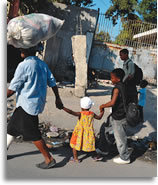 |
|
Photo courtesy
|
After a long day of trekking through pulverized cities, Rev. Glenn Merritt joins a late-night worship service at First Lutheran Church in Jacmel, Haiti. Piles of dusty rubble still cover the bodies of Haitians who not so long ago were working, studying, shopping, and playing.
Tears fill the eyes of the LCMS director of disaster response (a former police officer and search-and-rescue veteran) as some 200 homeless earthquake survivors gathered at the church compound break into soaring harmony. Their hymn, sung in French: “How Great Thou Art.”
When a fellow Lutheran questions how the LCMS can make a difference in a country with huge challenges before the earthquake and facing even more now, Merritt talks about that service in Jacmel. He calls it one of many “moments of mercy” he experienced in Haiti after the Jan. 12 disaster that killed an estimated 230,000 (the same death toll as the 2004 Asian tsunami) and left some 1.5 million homeless.
On behalf of the LCMS, LCMS World Relief and Human Care (the Synod’s mercy arm) is working cooperatively with LCMS World Mission (the Synod’s sending arm), LCMS districts and congregations, Haitian mission societies, and Haitian Lutherans to
bring what Merritt calls “moments of mercy into a life in misery.”
“The [Haitian Lutheran] pastors told us over and over again that the best thing we have done was to come to them and be with them during this national tragedy,” says Merritt, who traveled with the Haitian pastors and representatives from LCMS World Relief and Human Care (LCMS WR-HC) and LCMS World Mission to evaluate needs after the 7.0 magnitude earthquake. “I was told that our presence helped them to continue ministering in such difficult times. When we can give them hope… they pass that hope on to the suffering masses in Haiti.”
After the TV Cameras Leave
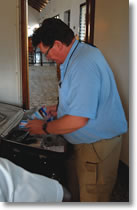 |
|
Chaplain Steve Lee, a critical incident stress specialist and member of the LCMS assessment team, prepares to give out medical supplies in Port-au-Prince.Photo courtesy
|
Today, the LCMS has moved beyond the early emergency stage into the next steps of a disaster response that, both American and Haitian Lutherans pray, will continue to share hope in Haiti long after the Western Hemisphere’s poorest country disappears from nightly newscasts. Providing funds for food, water, and shelter and shipping additional supplies (including medicine) are ways the Synod is assisting the Caribbean nation. (Visit lcms.org/witness for a sampling of the many LCMS partners working on the Haiti earthquake response.) But the LCMS also is walking alongside Haitian Lutheran partners, reaching out through local congregations and touching hurting people.
One such partner is the Evangelical Lutheran Church of Haiti (ELCH), an LCMS partner church since 2001. “The ELCH has strong leaders we already were working with before the earthquake,” says Rev. Dr. Jorge Groh, regional director for Latin America with LCMS World Mission who also assessed needs in Port-au-Prince and Jacmel, the hard-hit hometowns of many Haitian Lutheran congregations. “Now [the ELCH] can be strong partners as we work together to provide for material needs and more for the people in Haiti.”
Three weeks after the earthquake, two LCMS teams work in Jacmel, a city largely overlooked by aid organizations concentrating on the capital of Port-au-Prince. First Lutheran is the congregation of ELCH President Marky Kessa, one of many Haitian Lutheran pastors educated at Concordia Theological Seminary in Fort Wayne, Ind. Kessa “has great love for his people who are suffering so much and wants to do all he can as part of the body of Christ,” says Olga Groh, director of project management in Latin America and the Caribbean with LCMS World Mission and LCMS WR-HC.
A nine-person Mercy Medical Team (MMT) sets up a makeshift outdoor clinic at the First Lutheran compound. This is the second such group of medical volunteers coordinated by LCMS WR-HC to treat earthquake survivors. Three more MMTs are scheduled to staff the clinic into March.
Even as the MMT gets organized, a man who lost his leg in the earthquake hobbles over seeking pain relief. A steady stream of some 150 patients follows on that first day. MMT members also lend a hand at the local hospital where one doctor is overwhelmed with critical needs, including a 6-month-old baby who was buried in rubble for three days.
On the team’s fourth day in Jacmel, LCMS Life and Health Ministries director Maggie Karner rushes an 8-day-old infant from the First Lutheran clinic to the local hospital. The child is dehydrated and malnourished. “The mother brought the baby to us because she didn’t know what to do,” says Karner, explaining how team members treat the baby and teach the first-time mother about breastfeeding.
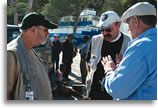 |
|
In Haiti, Director of Disaster Response Rev. Glenn Merritt (left), LCMS World Relief and Human Care Executive Rev. Matthew Harrison, and Rev. Dr. Jorge Groh, regional director for Latin America with LCMS World Mission, prepare for another day of assessing and responding to earthquake relief needs.Photo courtesy
|
The medical volunteers also give the young woman a tent when they learn she and the child sleep outdoors without shelter. They invite her to return to the church compound for food. When happy tears stream down the mother’s face, Karner calls the episode “one of those moments in life when you realize why we’re doing what we’re doing because we touched one life.”
LCMS teams also help Haitians open food programs at First Lutheran and Good Shepherd Lutheran Church in Port-au-Prince. The sites are expected to serve a total of 500 people daily for at least four weeks. Missionaries working with LCMS World Mission in the neighboring Dominican Republic coordinate the shipments of food, water, and cooking oil—urgently needed provisions made possible by generous donors who, to date, have given more than $3 million to LCMS WR-HC for the Haiti earthquake response.
Of course, tackling logistical challenges (including closed airports and blocked roads) to secure and transport supplies is nothing new for these missionaries. Almost as soon as the ground stopped shaking on Jan. 12, Rev. Ted Krey and the Dominican Republic mission team began coordinating efforts that provided food and medical care for hundreds of refugees who fled across the border.
While the clinic and feeding station in Jacmel meet physical needs, a pastoral care team offers spiritual support. An LCMS pastoral-care team comforts earthquake survivors at a refugee camp where as many as 5,000 Haitians live in haphazard tents, cooking rice and beans over open fires.
The pastors also listen and pray with their exhausted Haitian counterparts. As Haitian Lutheran leaders serve their weary flocks, they, too, deal with their own families’ needs and losses. The earthquake’s property toll includes 20 ELCH churches or facilities damaged or destroyed.
Rev. Thomas Bernard, pastor of Good Shepherd Lutheran in Port-au-Prince, says some Haitians believe the earthquake means “God is very upset with Haiti because some of the people are doing things which are . . . against God’s Word.”
But Bernard tells the LCMS pastors that he knows that God “is still with Haiti, and with us.” He and other ELCH pastors share the Gospel, assuring their fellow Haitians that “even though we are facing all these kinds of problems in Haiti, that doesn’t mean God doesn’t love us. He does love us.”
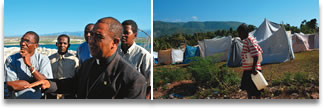 |
Left: Rev. Thomas Bernard, of the Evangelical Lutheran Church of Haiti (far left) and Rev. Marky Kessa, president of the ELCH, with ohter Haitian church leaders at the Dominican Republic-Haiti border.Right: A tent camp at JacmelPhotos courtesy Matt Schlanger and James Neuendorf |
The Next Steps
Lutherans, both in the United States and Haiti, know all too well that there are no simple solutions for a poor nation plunged into even deeper need. As he prepares to return to the United States, Merritt worries about how the approaching rainy season means more problems for earthquake survivors in flimsy tents. Helping to provide more sustainable shelter, water purification, and sanitation while continuing shipments of food, hygiene kits, medical supplies, and generators are among the “next steps” LCMS partners plan to address.
But despite overwhelming challenges, LCMS ministries also see hope. Rev. Matthew Harrison, executive director of LCMS WR-HC, points to the Synod’s improved disaster response. “We are more prepared for this disaster than we have ever been in the history of the LCMS,” said Harrison, citing strategies implemented over the past decade that helped build the LCMS capacity to respond in Haiti—and to the next crisis, whether that’s in the United States or overseas.
Harrison also sees hope for Haiti through lives touched “one at a time.”
“Our vocation is not to change Haiti, or to change the whole world, or to change the economic realities with which Haitians wrestle,” Harrison reflects as he gets ready to head home after providing pastoral care in Haiti. “Our vocation is to act and make a life-changing difference one at a time. And acting one at a time, we find that over some hours, over a few days, and over a couple of weeks, the flock of those helped in the name of Jesus has grown to be surprisingly large.”
—
Mercy Arm Reaches Out with a Uniquely Lutheran Response to Disaster
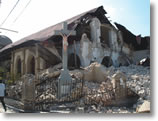 |
|
Crucifix and damaged Haitian churchPhoto courtesy
|
During a disaster, some people wrongly assume LCMS World Relief and Human Care (LCMS WR-HC) operates like a miniature American Red Cross. Instead, the Synod’s mercy arm seeks to complement, not compete with, other disaster relief organizations by reaching out in a uniquely Lutheran way that includes the following:
Working with local Lutheran partners. When a disaster hits, LCMS WR-HC joins forces with Lutheran partners (such as a partner church body or local congregations) already on the ground. This provides immediate contacts, enables relief efforts to quickly begin, and helps ensure that assistance reaches people in need. “In Haiti, we’re providing relief but also helping the ELCH (Evangelical Lutheran Church of Haiti) build their own capacity so they are better equipped for their struggles,” said LCMS WR-HC’s Rev. Dr. Albert B. Collver III.
Meeting both physical and spiritual needs. As a “body and soul” ministry, LCMS WR-HC provides material supplies as well as spiritual support.
Pastoral care teams comfort Haitian earthquake survivors who lost loved ones and homes. They listen to emotionally drained medical volunteers and pray with Haitian Lutheran pastors struggling to care for their congregations while they cope with their own losses. “After a disaster, people need someone to listen as they speak about what has happened,” said LCMS WR-HC’s Rev. Carlos Hernandez. “We don’t force our faith on anyone but, when invited, take the opportunity to say, ‘Jesus loves you.’”
Staying for the long haul. Long after a disaster disappears from the headlines, LCMS WR-HC continues to work with Lutheran partners to meet needs. In Asia, educational and vocational projects continue to assist survivors of the 2004 tsunami. Last year, an LCMS WR-HC Mercy Medical Team treated Indonesians still suffering from that disaster’s physical and emotional toll. One Indonesian told LCMS WR-HC’s Maggie Karner, “Others have left, but you [LCMS WR-HC] are still here.”
—
President Kieschnick to Visit Haiti in March
As The Lutheran Witness goes to press, LCMS president Dr. Gerald B. Kieschnick announced plans to travel to Haiti March 1 to meet with Haitian Lutherans as part of the Synod’s long-term disaster response.
Kieschnick’s plans include meeting with the pastors and people most directly affected by the destruction, including Evangelical Lutheran Church of Haiti president Marky Kessa. The trip’s purpose, the LCMS president said in a written announcement, includes “visiting, meeting, and praying with those most directly impacted by the destruction, joining together in prayer and planning relative to the ongoing details of the long-term LCMS response” and “upholding the work of our staff and volunteers on the ground who are providing direct relief assistance, medical care, and pastoral support.”
While he had hoped to schedule an earlier trip, Kieschnick said he continued to be informed that the logistical complexities would have prevented him and Kessa from meeting in Haiti “without logistical hassle and inordinate expense.”
Kieschnick said the trip’s timing reflects his desire “to be as helpful as possible to our brothers and sisters in Haiti as they cope with the aftermath of this disaster” and also support LCMS personnel “in a manner that will demonstrate the most faithful and fruitful stewardship of the many dollars contributed by LCMS people for Haiti relief.”
—
About the Author: Kim Plummer Krull is an editor-at-large for The Lutheran Witness and a member of St. Paul’s Lutheran Church, Des Peres, Mo.
Haiti at a Glance
by James Neuendorf
In 1804, slaves brought from Africa to Haiti rebelled against their French colonial overlords and created the first black republic in the New World. These unique circumstances have given birth to a rich and diverse culture that unfortunately also bears an overwhelmingly tragic history. In the past few decades alone, countless hurricanes, wars, and famines have ravaged this tiny nation, and many here are searching for hope and relief. Though far worse than any previous disaster, the present crisis is sadly just one crushing blow among many.
Occupying the western half of the sun-soaked mountainous island of Hispaniola, and sharing its borders with the lush Dominican Republic and the turquoise waters of the Caribbean, the chalky white barrens of Haiti and its struggling citizens seem distinctly out of place. Eighty percent of Haiti’s population of nearly 9 million lives in poverty, with half struggling to obtain even the most basic needs such as food or clean water. At 680 people per square mile, Haiti is the most densely populated country in the western hemisphere. Most scratch out a living through small-scale subsistence agriculture, though soil erosion caused by extreme deforestation renders much of the land infertile. One in 10 children do not survive infancy, and access to medical and sanitary facilities is limited at best.
Haiti stands out among the countries of Latin America as one of the very few nations that does not share the common language and culture of colonial Spain. French colonial culture and language fused with that of West African slaves to create a unique language known as Haitian Creole.
Echoing their West African roots, Haitians are deeply attuned to the spiritual world, place immense value in family relationships, and are extremely hospitable and generous. Most live in humble cinder-block homes, usually with little or no access to running water or electricity. Normally, when resources permit, Haitians eat three meals a day, mainly consisting of rice and beans, but often including pork, goat, fish, or local tropical fruits. Haitians value time spent visiting with each other, and when employment is available, are hardworking. Accustomed to hardship, Haitians are a strong and resilient people with an inspiring attitude.
Though the vast majority claims affiliation with the Roman Catholic Church, voodoo, a Caribbean version of West African shamanism, permeates the society. Under the pseudonyms of Catholic saints, demonic spirits are called upon and worshiped by many Haitians seeking supernatural aid to their constant challenges in daily life.
The Lutheran Church has had a strong presence in Haiti for many years. Beginning in 1978, individuals and groups from the LCMS started working with Haitian Lutherans to expand local mission opportunities. The Evangelical Lutheran Church of Haiti (ELCH) is strongly confessional, and many of its leaders received their training from LCMS seminaries in the United States.
Since 2001, the ELCH has been in altar and pulpit fellowship with The Lutheran Church—Missouri Synod, and it continues to work closely with several LCMS mission societies and congregations. LCMS World Mission has one GEO (longterm) missionary currently serving in Les Ceyes, Haiti, as a deaconess intern of Concordia Theological Seminary, Fort Wayne, Ind., under the supervision of a Haitian pastor. Alyssa Stone and her two daughters have been serving in Haiti for nearly six months. The current president of the ELCH is Rev. Marky Kessa.
Unfortunately, divisions within the church have caused the ELCH to split into smaller groups, which while in doctrinal agreement, are still in the process of Christian reconciliation.
—
About the Author: James Neuendorf is a communications specialist missionary with LCMS World Mission in Latin America.
On the Web
To contribute to Haiti relief online, visit www.lcms.org/help.
To learn more about:
LCMS World Relief and Human Care, visit www.lcms.org/worldrelief.
LCMS earthquake response efforts in haiti, visit www.lcms.org/help.
Mercy Medical Teams, visit www.lcms.org/mercyteams.
LCMS World Mission Haiti updates, visit www.lcmsworldmission.org.
Rev. John T. Pless, assistant professor of pastoral ministry and missions and director of field education at Concordia Theological Seminary, Fort Wayne, Ind., offers a reflection on the ancient question: Why is there suffering?”
Additional stories about Haiti and our Synod’s response are available also at the online site of Reporter, our sister publication. Visit www.lcms.org/reporter.





